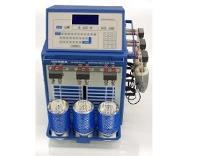 Add My Company
Add My Company
Sign In

Surface area analysis refers to the measurement of a particle?s available surface. It is important because it is the means by which a solid interacts with its surroundings, whether they are gases, liquid, or other solids. Generally as particle size decreases, surface area increases, however if porosity is generated the increase in surface area can be well in excess of any increase produced by size reduction.
On small porous particles, surface areas can be larger than the area of a football pitch (hundreds of meters squared) per gram. Ostensibly, surface area analysis is crucial for understanding numerous rate-related phenomena such as catalyst activity, bioavailability, electrostatic properties of powders, light scattering, opacity, sintering properties, glazing, moisture retention, shelf-life and many other properties which can influence the processing and behavior of powders and porous solids.
This article will explore the importance and performance of surface area analysis in two applications in more detail.
Surface Area Analysis of Pharmaceuticals
Pharmaceutical composition values can be detrimentally impacted by adsorption and permeation. Small molecule polymer species can leach into drug products from packaging media, while process gas can adhere to the surface of pharmacological products during the development process. These undue reactions can reduce the mechanical stability of a drug and thus its service life or efficacy.
Understanding the porous structure of inert materials and active ingredient compounds can improve the physical integrity of drug products and reduce the risk of amorphous phase transitions due to moisture uptake or contamination from leachable elements. The surface area of dosage form pharmaceutical particles is also critical for understanding the solubility the product, thus its uptake rates.
Surface Area Analysis of Solid Catalysts
Catalysts alter the rate of a process reaction by interacting with chemical analytes and altering the activation energy to optimize process conditions. This is achieved through particle collision. Granulated catalytic materials and catalysts with larger surface areas typically raise the rate of a reaction by providing increased potential surface area particle collisions.
Surface area analysis of catalytic materials is important for a growing range of industry sectors, from the assessment of antibacterial nanoparticles to quality control of catalytic converters in the automotive sector.
Surface Area Analysis with Meritics At Meritics, we have sourced a concise range of outstanding surface area analyzers using distinct analytical methodologies. Our range includes:
The Thermo Scientific Surfer: for specific surface area and pore volume for ultra-micro, micro, and mesopore size distribution through static volumetric gas adsorption, with a temperature stability to within +/- 0.1?C;
The Horiba SA-9600: for both single and multi-point surface area analysis with a range of 0.10 ? 2,000 m2/g.
Each of these instruments can be used for surface area analysis of active or inert ingredients of pharmaceuticals, and for catalyst assessment. If you would like any more information about performing surface area analysis with our instrumentation, please do not hesitate to contact us.
For more information on Outlining the Importance of Surface Area Analysis talk to Meritics Ltd
Enquire Now
More News
List your company on FindTheNeedle.

